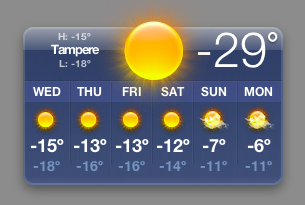A Ruby/Rails meme! Mike started and Robby followed up, so here you go:
$ gem list|grep '^[a-zA-Z]'
action_profiler (1.0.0)
actionmailer (1.3.2, 1.3.1, 1.2.5.5618, 1.2.5)
actionpack (1.13.2, 1.13.1, 1.12.5.5618, 1.12.5)
actionwebservice (1.2.2, 1.2.1, 1.1.6.5618, 1.1.6)
activerecord (1.15.2, 1.15.1, 1.14.4.5618, 1.14.4)
activesupport (1.4.1, 1.4.0, 1.3.1.5618, 1.3.1)
acts_as_taggable (2.0.2)
aws-s3 (0.2.1)
betabrite (0.0.2)
builder (2.0.0)
cached_model (1.2.1)
capistrano (1.3.1, 1.2.0)
cgi_multipart_eof_fix (1.0.0)
cheat (1.2.1)
daemons (1.0.4, 1.0.1)
deprec (1.2.1)
facets (1.7.46)
fastthread (0.6.2, 0.6.1, 0.5.3.1)
ferret (0.10.9)
flexmock (0.4.3)
gem_plugin (0.2.2, 0.2.1)
gettext (1.8.0)
gruff (0.2.8, 0.2.4)
heckle (1.1.1, 1.1.0)
hoe (1.1.6, 1.0.4)
io-reactor (0.05)
memcache-client (1.1.0)
mime-types (1.15)
mocha (0.3.3, 0.3.2)
money (1.7.1)
mongrel (1.0, 0.3.14, 0.3.13.4)
mongrel_cluster (0.2.1, 0.2.0)
mysql (2.7)
needle (1.3.0)
net-sftp (1.1.0)
net-ssh (1.0.10)
ParseTree (1.6.2)
payment (1.0.1)
piston (1.3.0, 1.1.1)
production_log_analyzer (1.3.0)
rails (1.2.2, 1.2.1, 1.1.6.5618, 1.1.6)
rails_analyzer_tools (1.1.0)
railsmachine (0.1.1)
rake (0.7.1)
rcov (0.7.0.1)
RedCloth (3.0.4)
rmagick (1.14.1)
Ruby-MemCache (0.0.1)
ruby2ruby (1.1.2)
rubyforge (0.3.2, 0.2.2)
RubyInline (3.6.2)
selenium (0.7)
shipping (1.3.0)
sources (0.0.1)
sqlite-ruby (2.2.3)
sqlite3-ruby (1.1.0)
tddmate (0.1)
termios (0.9.4)
tidy (1.1.2)
tzinfo (0.3.2)
xml-simple (1.0.10)
ZenTest (3.4.2)
I still curse the day I had to reinstall gems and lost my Rails versions around 0.3.








